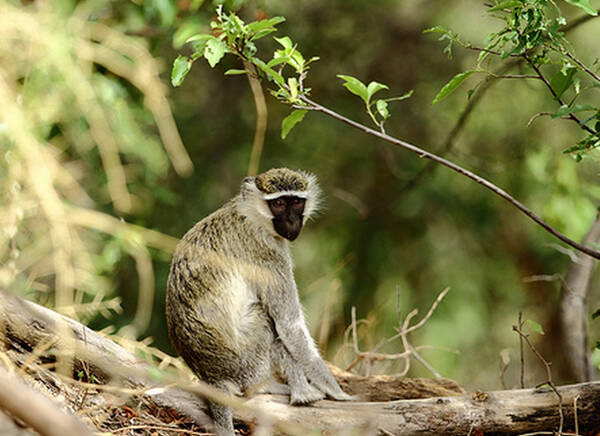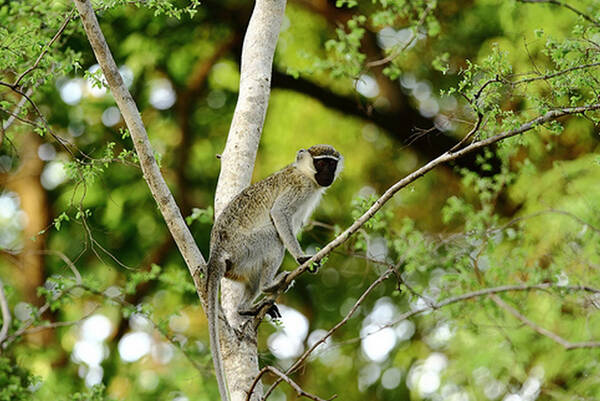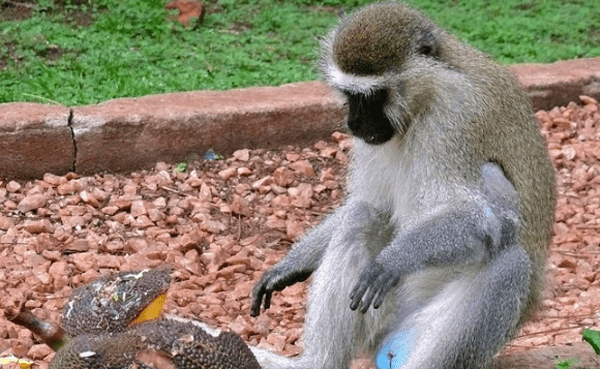Chlorocebus tantalus
IUCN
LCBasic Information
Scientific classification
- name:Chlorocebus tantalus
- Scientific Name:Chlorocebus tantalus, Tantalus Monkey, Vervet tantale,Vervet de Tántalo,Tantalus-Grünmeerkatze、Tantalus-Meerkatze,Tantalus monkey
- Outline:Primates
- Family:Cercopithecidae G.Monkey
Vital signs
- length:45-50cm
- Weight:3.5-8kg
- lifetime:About 13 years
Feature
It is a very intelligent animal.
Distribution and Habitat
Distributed in Benin, Burkina Faso, Cameroon, Central African Republic, Chad, Congo, Democratic Republic of, Ghana, Kenya, Niger, Nigeria, Sudan, Togo, Uganda.
Tantalus green monkeys are found in a variety of habitats, including savannahs, open woodlands and forests, forest-savannahs, mountains, rivers, and edges of degraded forests. They prefer woodlands and grasslands, especially open woodlands. They are limited by the availability of water and sleep trees, generally choosing places close to rivers and streams. A study in northern Cameroon reported that Tantalus green monkeys established their homes along rivers within a range where water never completely dried up, even during the dry season. Demonstrating the flexibility of the species, they also inhabit cultivated rural lands, degraded habitats and forest edges, as well as human-dominated landscapes in suburban areas.
Appearance
Tantalus green monkey is a medium-sized monkey, with adult males weighing 4-8.8 kg and an average body length of 500 mm; females weighing 3.5-5 kg and about 450 mm in length. The whole body is covered with thick golden fur with green tones. The cheeks are hairless, but covered with soft white hair around them, highlighting the outline of the blue-black skin. Like other monkeys, they have slender tails. Males and females are dimorphic. The scrotum of males is blue, and the penis is obviously red. The color combination presents a distinct "red, white, and blue" display.
The snout is prominent, the two jaws are strong, there are 32 teeth, the nostrils are close together facing forward and downward, and the hands and feet have 5 fingers and toes, with flat nails, and can all stand upright. It is diurnal. It has cheek pouches that can store food, the teeth are low, and the diet is relatively mixed. Usually the limbs are basically equal in length.
Details
Tantalus green monkey (scientific name: Chlorocebus tantalus) English Tantalus Monkey, French Vervet tantale, Spanish Vervet de Tántalo, German Tantalus-Grünmeerkatze, Tantalus-Meerkatze, is a medium-sized monkey.

The size of the Tantalus green monkey home range varies depending on the number of clusters, the dispersion and availability of food. The home range of a large group can be 90 hectares. The home range varies from 43 hectares to 90 hectares.
Tantalus green monkeys are highly social animals. They like to live in groups and are very smart animals. Usually, group members often communicate with each other by raising eyebrows, squinting, and pouting. Tantalus green monkeys, like other monkeys, often groom each other and like to "catch lice" for each other to show intimacy. Usually, male monkeys groom male monkeys and female monkeys groom female monkeys. It is rare for the two sexes to "catch lice" for each other. In the breeding season, males and females groom each other, which is a sign of intimacy between spouses.

Tantalus green monkeys are a very vocal primate. Vocalization is mainly used to alert members of the same tribe that there is danger. Tantalus green monkeys can use different calls to distinguish between various enemies and levels of danger, and males can also communicate through body language. Use brightly colored genitals. Or they can use more subtle communication methods through facial expressions. Studies have shown that facial expressions are related to emotional states. Anger, elation, and even emotional frustration all show different facial expressions. Tantalus green monkeys use facial expressions to indicate danger or satisfaction, depending on the situation.
In the wild, Tantalus green monkeys have different screams for different dangers. One sound may indicate that a leopard is lurking nearby, while another sound may indicate that a human is threatening it. Because they live in the jungle covered by leaves, they can hear each other's shouts but cannot see each other, so they must be able to distinguish accents. Tantalus green monkeys from different families have subtle differences in accents, which is important. For example, a female animal will rush to rescue her cubs more quickly if she hears the cries for help from her cubs than if she hears the cries for help from other members of the same species.
Tantalus green monkeys mainly feed on fruits and leaves. Food resources depend on the year and environmental conditions. During the dry season or after a fire, when only a few fruits are available, Tantalus will forage for edible plants throughout the grasslands, including grass blades and roots, which have little nutritional value. However, when rains are plentiful and fruit becomes more abundant, it is common to gather fruit, including wild bananas, papayas, and mangoes. In the wild, Tantalus often use cheek pouches to store and carry food. These cheek pouches are present in all members of the monkey family and allow food to be collected and preserved.

The social structure of Tantalus green monkeys is male-dominated and is a polygamous mating system. The breeding season is from April to June. Usually the area where Tantalus green monkeys live enters a heavy rainfall pattern. The abundant rainfall provides sufficient food sources and also makes the nutritional resources grow exponentially. This special breeding season adapts to the advantages of abundant resources. Reproduction occurs once a year. Females reach sexual maturity in 2 years and males in 5 years. From birth, the female monkey carries her offspring tightly on her body. She cares for her young for about 1 year until they are fully weaned and independent. The life span in captivity is about 11-13 years.
Tantalus green monkeys are highly frugivorous animals, which play a great role in the entire ecosystem and the spread of plant seeds. In addition, their diet is mainly herbivorous, which does not compete with insects, birds, bats and other primate species. The large population density of Tantalus green monkeys makes them a food source for many carnivores. Natural enemies include African cats and birds of prey, and sometimes baboons will also capture Tantalus green monkeys. Parasites are common in Tantalus green monkeys. The most common in wild Tantalus green monkeys are protozoan parasites and worms, which are the biggest troubles facing green monkeys.
Listed in the IUCN Red List of Threatened Species in 2019 ver3.1 - Least Concern (LC).
Listed in the CITES Appendix II of the Washington Convention as a protected animal.
Protect wild animals and eliminate game.
Maintaining ecological balance is everyone's responsibility!








